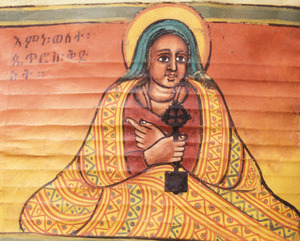Walatta Petros facts for kids
Quick facts for kids Walatta Petros |
|
|---|---|

Portrait of Walatta Petros painted in 1721
|
|
| Abbess | |
| Born | c. 1592 Ethiopian Empire |
| Died | 23 November 1642 (aged 49–50) |
| Venerated in |
|
| Patronage | Ethiopians |
| Influenced | Ehete Krestos |
Walatta Petros (born 1592 – died 23 November 1642) was an important Ethiopian saint. She is remembered for standing up against changes to her religion. She also started many religious groups. People seeking safety from kings often came to her, and she was known for performing miracles.
Contents
Understanding Walatta Petros's Name
Walatta Petros's name in the Ge'ez script looks like this: ወለተ ጴጥሮስ. It means "Daughter of [Saint] Peter." You might see her name spelled in different ways. Some common spellings include Walata Petros or Waletta Petros. It is important not to shorten her name to just "Petros."
Walatta Petros's Life Story
Her Early Years and Family
Walatta Petros was born in 1592 in the Ethiopian Empire. Her family was noble, meaning they were important and owned land. Before she was born, her parents were told she would become a very important religious leader. Her father and brothers worked for the king.
Walatta Petros married at a young age. Her husband, Malka Krestos, was a trusted advisor to Emperor Susenyos I. She had three children, but sadly, they all died when they were babies. After this great sadness, she decided to become a nun.
Becoming a Nun and Standing Firm
In 1612, Emperor Susenyos secretly changed his religion to Roman Catholicism. He then asked Walatta Petros's husband to stop people who were against this change. While her husband was away fighting, Walatta Petros left him. She went to a monastery on Lake Tana.
There, she took a special promise to live a religious life. She shaved her head and became a nun in the Ethiopian Orthodox Tewahedo Church. She refused to change her religion to Roman Catholicism. Church leaders asked her to go back home because her husband was causing trouble. She returned, but when she learned her husband had supported killing a church leader, she left him for good. She became a nun permanently in 1617, at age 25.
Resisting the Emperor and Forming Communities
In 1621, Emperor Susenyos said people could no longer teach the Ethiopian Orthodox faith. Walatta Petros began to speak out against the emperor. She felt he was abandoning their traditional beliefs for foreign ones. In 1622, she was called to court for her protests. The emperor wanted to harm her, but her family convinced him not to.
She then moved to northern areas and started preaching. She told people to reject the new faith and not even mention the emperor's name in church prayers. This was seen as treason (betraying the king). In 1625, she was called to court again. Her husband again saved her from harm. The king sent a Catholic priest, Afonso Mendes, to try and convert her. When he failed, the king sent her away to Sudan for three years.
This exile marked the start of her leadership. She began to lead groups of people who wanted to escape Roman Catholicism. Over her life, she created seven religious communities. The first was in Sudan, and six more were around Lake Tana.
Meanwhile, in 1632, Emperor Susenyos stopped trying to make everyone Catholic. His son, Fasilides, became the new king. King Fasilides worked to remove Roman Catholicism from the country.
Later Life and Legacy
Walatta Petros continued to lead her traveling religious community. She led it with her close friend, Ehete Kristos, without male leaders. After being sick for three months, Walatta Petros died on November 23, 1642. She was 50 years old and had been a nun for 26 years. Many people from the Lake Tana islands mourned her death. They saw her as a mother figure. Her friend Ehete Krestos took over as the leader of the community until her own death in 1649.
In 1650, King Fasilides gave land on Lake Tana for a monastery. This monastery, called Qwarata, was dedicated to Walatta Petros. Since the 1600s, it has been a safe place for people seeking protection from the king.
The Story of Her Life: Hagiography
Walatta Petros is one of 21 female saints from Ethiopia. Six of them have special biographies called hagiographies. A hagiography tells the life story of a saint and describes their miracles. Walatta Petros's hagiography, called Gädlä Wälättä P̣eṭros, was written in 1672. This was 30 years after she died.
A monk named Gälawdewos wrote it. He gathered stories from people who knew her. He also added his own thoughts. The book has three parts: her life story, stories of miracles that happened after her death, and two hymns (songs of praise). Later, more miracle stories were added to the book.
Many copies of her hagiography were made by hand in Ethiopia. The first printed version came out in 1912. The first translation into another language, Italian, was published in 1970. In 2015, the first English translation was released. It included colorful pictures from old manuscripts.
Studying Walatta Petros
For a long time, not much was written about Walatta Petros in Western studies. Before 2015, some information about her was incorrect. This included details about her birth, death, and travels.
However, in the 21st century, more has been published about her, mostly in English. Scholars have studied her life and her importance. For example, one scholar argued that Walatta Petros was one of the noble Ethiopian women who helped defeat Roman Catholicism in Ethiopia in the 1600s. Her story continues to be studied and shared.

